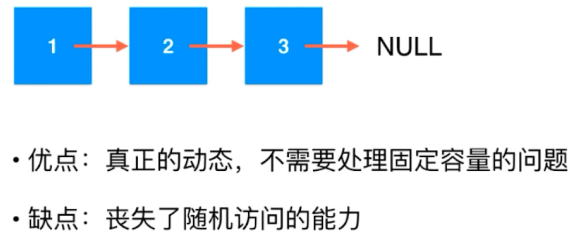什么是链表:
我们之前已经学过了 动态数组,栈和 队列 三种我们自己定义的数据结构。它们三者的底层都是依托静态数组(使用resize解决容量问题)。
而下面我们学习的链表,它才是真正的动态数据结构。
为什么链表很重要:
1,它是最简单的动态数据结构,有助于学习后面更加复杂的数据结构。
2,有助于更深入的理解引用 (Java) 指针(c/c++)。
3, 有助于更深入的理解递归。
4, 辅助组成其他数据结构。
链表基础:


数组 和 链表 的对比:

代码:

1 package cn.zcb.demo04; 2 3 public class LinkedList <T> { 4 private class Node{ 5 public T data;//具体数据 6 public Node next; //引用(指针) 7 8 //Node 节点的构造器 9 public Node(T data,Node next){ 10 this.data = data; 11 this.next = next; 12 } 13 public Node(T data){ 14 this(data,null); 15 } 16 public Node(){ 17 this(null,null); 18 } 19 20 @Override 21 public String toString(){ 22 return this.data.toString(); 23 } 24 25 } 26 27 28 }
在链表中添加元素:

1 package cn.zcb.demo04; 2 3 public class LinkedList <T> { 4 private class Node{ 5 public T data;//具体数据 6 public Node next; //引用(指针) 7 8 //Node 节点的构造器 9 public Node(T data,Node next){ 10 this.data = data; 11 this.next = next; 12 } 13 public Node(T data){ 14 this(data,null); 15 } 16 public Node(){ 17 this(null,null); 18 } 19 20 @Override 21 public String toString(){ 22 return this.data.toString(); 23 } 24 25 } 26 27 private Node head; //头节点 28 private int size; 29 //LinkedList 的构造器 30 31 public LinkedList (){ //只需要空参构造器 , Node() 实例化需在LinkedList 内部实现!!!外部无法实现。 32 this.head = null; 33 this.size = 0; 34 } 35 //获取链表中的元素个数 36 public int getSize(){ 37 return this.size; 38 } 39 //返回链表是否为空 40 public boolean isEmpty(){ 41 return this.size ==0; 42 } 43 44 //在链表头添加 新的元素 newData 45 public void addFirst(T newData){ 46 // Node newNode = new Node(newData,null); 47 // 48 // newNode.next = this.head; 49 // this.head = newNode; 50 //下面是更简洁的写法 51 this.head = new Node(newData,this.head); //一句话 顶上面三句话。 52 this.size ++; 53 } 54 //在链表 中间 索引(idx) 添加新元素 55 public void insertByIdx(int idx,T newData){ 56 if(idx <= 0 || idx > this.size){ 57 //在链表头插入 58 this.addFirst(newData); 59 return; 60 } 61 Node tempPtr = new Node(); 62 tempPtr = this.head; 63 for (int i =0;i< idx -1 ;i++){ 64 tempPtr = tempPtr.next; 65 } 66 Node node = new Node(newData,tempPtr.next); 67 tempPtr.next = node; 68 69 this.size ++; 70 } 71 72 //在链表尾部 添加新元素 73 public void addLast(T newData){ 74 this.insertByIdx(this.size,newData); 75 } 76 77 @Override 78 public String toString(){ 79 StringBuilder builder = new StringBuilder(); 80 builder.append(String.format("LinkList's Data is below: [size:%d] \n", this.size)); 81 Node tempPtr = this.head; 82 83 while (tempPtr !=null){ 84 builder.append(tempPtr.data +", "); 85 tempPtr =tempPtr.next; 86 } 87 return builder.toString(); 88 } 89 90 }
为链表设立虚拟头节点(重要):
在前面 在链表中添加元素的时候,我们会发现, 操作链表头节点和 操作其他的节点的时候的逻辑会不同。
这时因为,链表头节点的前面已经没有节点了。所以它和其他的节点会有区别。

这样头节点的处理逻辑 就和其他的节点一致了。

1 package cn.zcb.demo04; 2 3 public class LinkedList <T> { 4 private class Node{ 5 public T data;//具体数据 6 public Node next; //引用(指针) 7 8 //Node 节点的构造器 9 public Node(T data,Node next){ 10 this.data = data; 11 this.next = next; 12 } 13 public Node(T data){ 14 this(data,null); 15 } 16 public Node(){ 17 this(null,null); 18 } 19 20 @Override 21 public String toString(){ 22 return this.data.toString(); 23 } 24 25 } 26 27 private Node dummyHead; //虚拟头节点 28 private int size; 29 //LinkedList 的构造器 30 31 public LinkedList (){ //此时,当链表初始化的时候就已经存在一个 虚拟的头节点了。 32 dummyHead = new Node(null,null); 33 this.size = 0; 34 } 35 //获取链表中的元素个数 36 public int getSize(){ 37 return this.size; 38 } 39 //返回链表是否为空 40 public boolean isEmpty(){ 41 return this.size ==0; 42 } 43 //在链表 中间 索引(idx) 添加新元素 44 public void insertByIdx(int idx,T newData){ 45 if(idx < 0 || idx > this.size){ 46 throw new IllegalArgumentException("idx 错误!"); 47 } 48 Node tempPtr = new Node(); 49 tempPtr = this.dummyHead; 50 for (int i =0;i< idx;i++){ 51 tempPtr = tempPtr.next; 52 } 53 Node node = new Node(newData,tempPtr.next); 54 tempPtr.next = node; 55 56 this.size ++; 57 } 58 59 //在链表头添加 新的元素 newData 60 public void addFirst(T newData){ 61 insertByIdx(0,newData); 62 } 63 //在链表尾部 添加新元素 64 public void addLast(T newData){ 65 this.insertByIdx(this.size,newData); 66 } 67 68 @Override 69 public String toString(){ 70 StringBuilder builder = new StringBuilder(); 71 builder.append(String.format("LinkList's Data is below: [size:%d] \n", this.size)); 72 Node tempPtr = this.dummyHead.next; 73 74 while (tempPtr !=null){ 75 builder.append(tempPtr.data +", "); 76 tempPtr =tempPtr.next; 77 } 78 return builder.toString(); 79 } 80 81 }
注意:有了虚拟头节点,插入时的遍历就不是从真正的head 开始了,而是从虚拟头节点开始遍历。 注:查看时候的遍历是从真正的head 开始的。

1 package cn.zcb.demo04; 2 3 public class Test { 4 5 public static void main(String[] args) { 6 LinkedList<Integer> linkedList = new LinkedList<>(); 7 // for (int i =0;i<10;i++){ 8 // linkedList.addFirst(i); 9 // } 10 11 12 linkedList.addLast(12); 13 linkedList.addLast(11); 14 for (int i=0;i<6;i++){ 15 linkedList.addLast(i); 16 } 17 System.out.println(linkedList); 18 19 20 linkedList.addFirst(15); 21 linkedList.addFirst(15); 22 linkedList.addFirst(15); 23 linkedList.addFirst(15); 24 System.out.println(linkedList); 25 linkedList.addLast(12); 26 linkedList.addLast(12); 27 linkedList.addLast(12); 28 linkedList.addLast(12); 29 linkedList.addLast(12); 30 System.out.println(linkedList); 31 32 33 34 } 35 36 37 38 39 }
总结:
虚拟头节点为 添加元素 统一了处理逻辑。这是很重要的一点!!!
